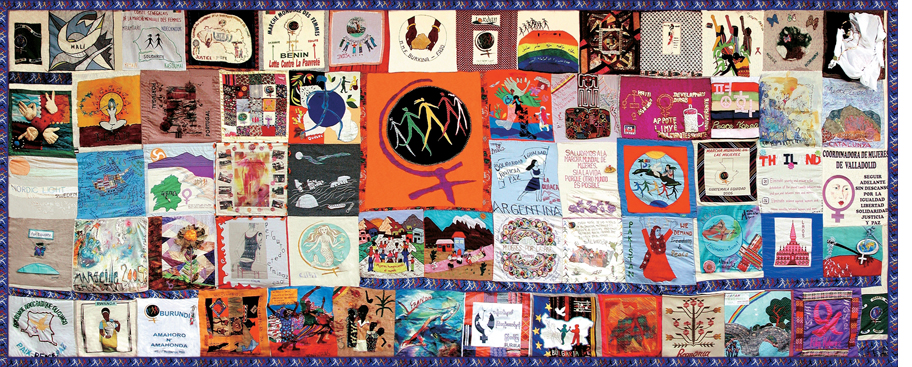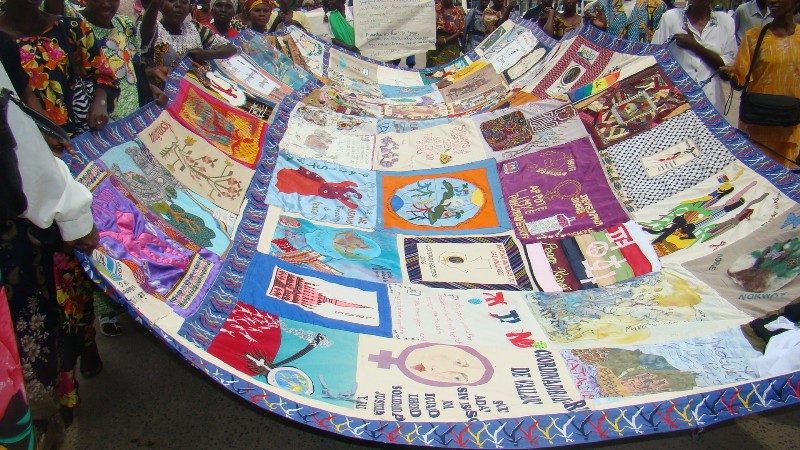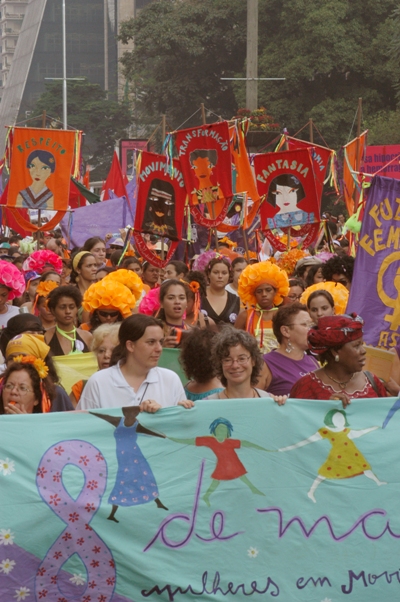The Solidarity Quilt
Women Stitch Visions for a New World
A Relay for Change
Today, the solidarity quilt covers a wall at the World March of Women's South Africa office. The collective creation of hundreds of individual women's hands, the quilt circled the globe before arriving here. Like any world traveler, it has many stories to tell.
In 2005, the World March of Women decided to debut their new global charter for humanity by creating a relay around the world. At each of 64 stops, participants gathered at events to raise awareness about the charter and garner support from elected representatives. And, at each stop, the local women stitched together a quilt patch to represent their country and illustrate one of the values of the charter. As the charter moved around the globe, the solidarity quilt took form, one square at a time.
Women Take Action
The world relay was launched on March 8, 2005, International Women's Day, in Sao Paolo, Brazil. Thirty thousand Brazilian women took to the streets to demand salary increases, agrarian reform and abortion rights. The Brazilian quilters came up with symbols, forms and colors for their country's patchwork after reading and discussing sections of the charter during a workshop. The result is a brilliant collage of hands, feet, flowers and butterflies, capturing what workshop participants described as "the vivid memory of the day we took to the streets."
In Jordan, Palestinian and Jewish women participated in a workshop on violence against women and its relationship to the current occupation. In Japan, women demonstrated in the streets to denounce the militarization of their country. In Portugal, women organized sessions in schools to raise awareness about the charter.
One Woman's Vision
While many patches were a group effort, some were the work of individual artists. Ana Salazar, one of Portugal's most influential fashion designers, designed and sewed her country's quilt patch. "The spirit of my collections and my work has always been that of the free expression of the female body," Salazar said at the unveiling of her design. "At the core of my work there has always been the image of a woman who dares to fight for whatever she desires. This square of the patchwork quilt is a reflection of that."
A Country's Symbol
"Each square has a story to tell and a meaning behind it," says World March of Women's International Secretariat Miriam Nobre. "The pieces illustrate not only the values expressed in the charter but also reflect each country's particular visual art, colours, textures, and materials."
In Cameroon, the square was made on traditional fabric made from beaten tree bark. Rwanda's square is embroidered with a woman draped in traditional clothes in the colors of the national flag. The basket she holds traditionally appears closed, containing women's secrets. But hers is shown open, revealing five values of the global charter inside.
From Hand to Hand
Wherever possible, the World March of Women transferred the quilt and charter across international borders by hand. They organized ceremonies as the quilt passed from Bolivia to Peru, from India to Pakistan and from Lebanon to Tunisia.
The quilt passed from Portugal into the Galician region of Spain not only by hand, but also over water. Portuguese historian Fina d'Armada describes the scene: "Teams of women rowers from two locations escorted the ferry, everyone wearing the same colours, mostly orange, as if to say that women had abolished the border and that there were no longer any distinctions between Portuguese and Galician women."
The Last Stitch
The women of Burkina Faso sewed the last of the 64 quilt patches, tying off the final stitches to the quilt on October 17th, 2005, the International Day for the Eradication of Poverty. But the solidarity quilt's traveling days are not over. The quilt is still sent to each international convention of the World March of Women as an artistic representation of women's collective vision for a better world.
"The quilt is our global charter for humanity expressed in a different way," says World March of Women's Miriam Nobre. "It is our dreams, the different world we're struggling for, materialized. It shows we see the changes not only in the future but now."
For more information, visit the World March of Women Web site.




